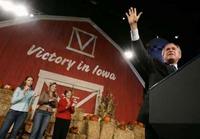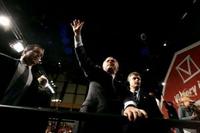A while back, I filled by DVD rental queue with over 100 movie suggestions from greg.org readers. Even combined with some of my own ongoing additions, I’ve depleted my queue completely. More suggestions are welcome,
In the mean time, here are some short reviews of DVD’s fresh from the queue:
Unknown Pleasures (2003, Zhang Ke Jia) The wrapper says, “think a Chinese Slacker, but it’s more a Chinese Reality Bites directed by Mike Leigh.
Super Size Me (2003, Morgan Spurlock) I wanted to play catchup, but it felt like most other things from SoHo these days–played out. If this were an order of fries, I could’ve done with a small.
Shadows (1959, John Cassavetes) Rewatched in the wake of the fleeting appearance of Cassavetes’ first version. It’s like an American Unknown Pleasures. My kid’s first movie (the B&W is good for their visual development, right?)
The French Connection (1971, William Friedkin) I confess, I got it because Nick Nolte loved it, and it’s a spare, elliptical classic. Felt like it had less dialogue–or a shorter script, anyway–than even Lost in Translation.
Capturing The Friedmans (2003, Andrew Jarecki) The DVD experience is so different than the film BECAUSE THERE’S CLEARLY EXONERATING EVIDENCE ON THE EXTRAS DVD. It’s like only finding out the secret of The Crying Game on the director’s commentary. Oh, and clowns disturb me.
Ridicule (1996, Patrice Leconte) Very very funny, but there’s a closeup of (pardon my French) a fat, uncut queue in the first scene that might make the rest of watching this movie with your inlaws rather uncomfortable.
The Godfather (1972, Francis Ford Coppola) Yeah, yeah, I just got it to study the editing of the baptism/massacre scene. You should see this in a theatre.
Tigerland (2000, Joel Schumacher) Joel Schumacher’s Full Frontal, Of course, Full Frontal was made in the wake of Erin Brockovich, Traffic, and Oceans Eleven and paid us back with Oceans Twelve [and, granted, K Street], whereas Tigerland only gave us Phone Booth.
Elephant (2003, Gus Van Sant) Even better the third time (I’d put it on the queue before I got it for my birthday), but with a positively Third World selection of DVD extras: i.e., almost none. Have someone read my interview with producer Dany Wolf to you while you watch it.
Faces (1968, John Cassavetes) Impressively depressing.
Come Undone (2000, Sebastien Lifshitz) For a brief moment after I turned it off, I planned to look up who the Stephane Rideau fanatic was who recommended this meandering gay French teen soap opera (as wel as Francois Ozon’s Sitcom) to me, and chew them out. Now that they have much bigger worries, I’m glad I didn’t.
Sign yourself up for DVD rentals at GreenCine.


 Huh, what’re the odds? I just finished a piece for an offline publication about machinima, and the first thing I see at this year’s Margaret Mead Documentary Festival is Beyond Manzanar, a video game-based exploration of the internment of Japanese Americans during WWII and political attitudes toward Iranian Americans during the 1979-80 hostage crisis. It was created by Tamiko Thiel and Zara Houshmand.
Huh, what’re the odds? I just finished a piece for an offline publication about machinima, and the first thing I see at this year’s Margaret Mead Documentary Festival is Beyond Manzanar, a video game-based exploration of the internment of Japanese Americans during WWII and political attitudes toward Iranian Americans during the 1979-80 hostage crisis. It was created by Tamiko Thiel and Zara Houshmand.



